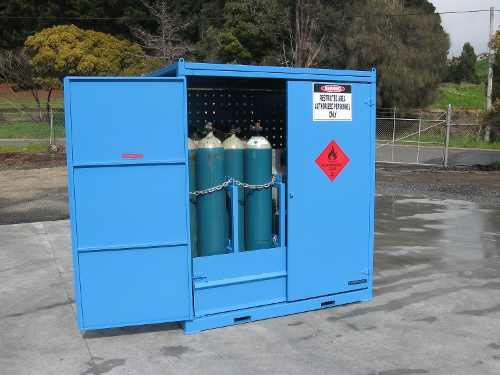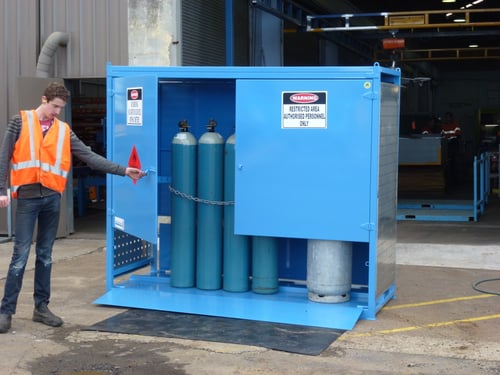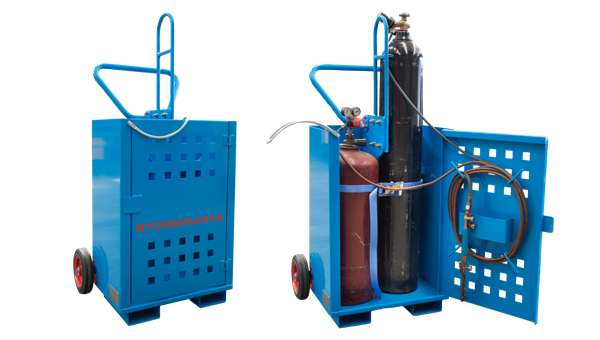Location
Before you install your gas cylinder cages, we recommend that you identify the safest and most practical area onsite. While stores can be either inside or outside, outdoor storage for gas cylinders is best practice.
Some of the biggest risks when storing compressed gases in cylinders are leaks, and this is the key reason why indoor storage of gas cylinders should be avoided wherever possible. If a gas leak occurs outdoors, in many instances the gas will be dispersed safely. But indoors, a whole room or building can quickly fill with gas. When gas like LPG — which is highly flammable and denser than air — collects in low areas instead of dissipating, accumulated gas remains in its explosive range.

Outdoor gas cylinder stores are best practice.
Storing gas cylinders requires a safe, secure and level site. We recommend the following considerations when installing your Storemasta gas cage:
- Base - The store should be at ground level, and any space between the cylinders and the ground filled with a solid base. We recommend bolting down your gas bottle stores or conducting a risk assessment to determine if this is necessary for your site.
- Level - The base materials must be sturdy, non-combustible and able to withstand all weather conditions without becoming indented or damaged.
- Traffic - Where possible locate storage areas away from traffic and machinery. If this is not possible then bollards or crash barriers must be installed to minimise the risk of cylinders being hit by vehicles
- Heat - Cylinder stores must not be close to artificial sources of heat — so away from radiators, boilers, steam pipes etc.
- Security - Untrained staff and other unauthorised personnel must not be able to access cylinder stores. Make sure the gas cage is kept locked.
Segregation
Like all hazardous chemicals, compressed gases must be segregated and separated according to their gas and hazard class. Segregation is about isolating incompatible gases from one another, whereas separation is about physically separating the gas cylinder stores away from site machinery and operations; pedestrians and traffic; other dangerous goods and hazardous chemicals.
In the Standard, the following gases must be segregated by at least 3 metres:
- Class 2.1 flammable gases (acetylene, LPG)
- Class 2.2 (5.1) non-flammable, oxidizing gases (oxygen)
- Class 2.3 toxic gases (chlorine)

Screen walls can also be used to achieve segregation distance and clear diagrams as well as detailed tables are provided in the standard. The 3 metre segregation rule also applies to combustible materials, refuse and vegetation.
However, you should always refer to your own SDS and risk assessment that considers all risk factors at your site including the quantity that you're storing and your fire risk.
NOTE: Segregation distances can vary according to the hazard class of each gas, plus the quantities being used and stored at your worksite.
Gas Cylinder Storage
Gas cylinders should always be stored upright in a secure safety cage and restrained by chains or safety straps. Valves must be closed, attachments removed, and safety caps in place.
The Standard also requires that -
- Copies of safety data sheets (SDSs) for each of the gases (plus first aid
equipment) are nearby. - Gas stores are NO SMOKING areas.
- Entry points and emergency exits are kept clear at all times.
- Adequate ventilation should maintain safe oxygen levels at all times, as well as safe gas exposure standards and within explosive limits.
Like all storage areas for dangerous goods, cylinder stores must also have correct signage. This includes safety labels, hazard statements, and placards.
Handling of Gas Cylinders
Gas cylinders are bulky and awkward so they create a significant manual handling risk. Not only are they heavy, but their slim design makes them unstable when standing. Australian Standard AS 4332 is very clear about handling gas cylinders and specifies the following:
- Always make sure the valves are closed and cylinder caps in place.
- Never apply excessive force to cylinder valves — so don’t lift or carry a gas cylinder using their valves, shrouds or caps.
- Always use a trolley or lifting device (like a forklift) for moving cylinders.
- Because a cylinder must always be protected from being knocked over, falling, or impact damage to the valve; make sure the trolley or lifting device has secure restraints and safety straps.
- Don’t drop or roll cylinders over the side of trucks (again use a forklift or other
lifting device).
Additionally, you should ensure that your staff are trained to:
- Not transfer or store cylinders with attachments (like welding torches) in place. Take care not to trap their fingers between cylinders.
- Use PPE like gloves and safety shoes (many workers have had their toes
crushed from dropped cylinders). - Never try to catch a falling gas cylinder — let the cylinder drop and get out of the way.
- Approach a fallen cylinder with caution, making sure that valves are intact and not leaking.

Empty Cylinders
According to the Standard, empty cylinders must be afforded the same precautions as full cylinders. Make sure they are used, stored and handled in the same manner as if they were full — this includes being properly segregated and separated. What this effectively means for your workplace, is you need additional cylinder stores for your empties. Because (just as if it were full) you cannot store an empty O2 cylinder with empty LPG cylinders.
Get in touch:
Need some further advice on gas cylinder storage for your workplace? Get in touch with our experienced Dangerous Goods Storage Consultants who can help you reduce the risks associated with Class 2 gases.
Further resources:
See some of our recent posts about gas cylinder storage and handling.Joining the team as a Dangerous Goods Storage Consultant, Melissa Hampton became Storemasta's Marketing Manager in late 2021. With extensive knowlege and experience in chemical compliance, Melissa is responsible for leading the Marketing team and helping shape their marketing strategy. In her spare time, you can find Melissa hiking, swimming and enjoying the great outdoors in beautiful north-west Tasmania.